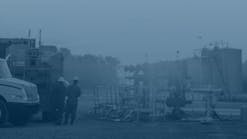Oman has formed a group to study construction of a 1.8-2 bcfd subsea pipeline to transport Omani gas to India.
If built, the $4 billion Oman-India line could play a key role in India's plan to press ahead with economic liberalization.
The project is part of an Omani campaign to create new outlets for its gas reserves, to which more than 20 tcf have been added with recent deep discoveries at Barik, Saih Nihayda, and Saih Rawl.
The proposed gas line is to be laid in three segments along one of these routes:
- A direct, deepwater route of about 900 miles consisting of either a single 38 in. line or two 28 in. lines from Sur, on Oman's eastern coast across the Gulf of Oman and Arabian Sea to a point on India's western coast.
- A shallow water route consisting of about 1,250 miles of 42 in. pipe from a point near Sohar on the Batinah coast, north across the mouth of the Persian Gulf, to India along the continental shelf off Iran and Pakistan.
Obstacles to pipeline construction along either route are formidable. Water depths along the direct route in some places exceed 3,000 m, and the pipeline would have to cross a subsea mountain range as well as the mouth of the Indus River. The longer but more shallow route would require crossing subsea canyons and steeply sloping sea bottoms.
The idea of laying two smaller diameter lines on the direct, deepwater route is being considered because of lesser technical and construction requirements.
Two gas lines also would allow staging of financing and could add supply security and flexibility by tying in at two points on the Indian gas distribution grid.
The pipeline could be completed along either route in time to begin operating by mid-1996.
PROJECT DETAILS
The project group formed to study technical and economic factors pertaining to the Oman-India gas pipeline project is led by Oman Oil Co. Ltd. (OOC) and includes McDermott-ETPM East Ltd., Saipem SpA, Snamprogetti SpA, and Bechtel Overseas Inc.
Saipem and McDermott, described by OOC as two of the largest, most experienced offshore pipeline contractors, are to study jointly the feasibility of laying a subsea pipeline along either proposed route.
Snamprogetti and McDermott unit Hudson Engineering Corp. are to identify and resolve associated engineering and construction requirements.
Bechtel is to evaluate the pipeline system's onshore segment in Oman and compression requirements.
Also, OOC has hired Engineers India Ltd. to evaluate the system's onshore segment in India, help pick shore approaches for the pipeline on India's coast, and help study India's gas demand.
According to the Oman-India gas pipeline agreement, the project is to be carried out in three phases:
- During the first phase, which began June 28, about 6 months are to be allowed to wrap up the development agreement.
- The second phase wall allow 9 months to complete preliminary engineering design, set project specifications, and prepare bid documents.
- The third phase, to last about 18 months, is to include completion of detailed engineering and procurement, construction, and commissioning of the pipeline.
GROWING ENERGY DEMAND
Omani officials said oil and gas demand in India is growing rapidly.
The Oman-India gas pipeline is expected to help India meet energy demand that during the past 15 years has increased at 1.6 times the growth rate of its gross national product (GNP).
Perceived gas marketing opportunities in India and a longstanding relationship between it and Oman prompted the two countries last March to sign a memorandum of understanding to study the feasibility of building a gas pipeline between the two countries. (OGJ, Mar. 22, Newsletter).
India is experiencing power shortages that hinder economic development in some regions.
Still, India's GNP in the next 4 years is forecast to grow at a rate of more than 4%/year.
India relies on coal as a major fuel for electrical power generation. But because Indian coal has a high ash and sulfur content, it is less attractive environmentally and economically than other hydrocarbon fuels.
Gas fueled power generating stations are attractive because of their environmental edge and short construction time.
In addition to linking Oman's gas reserves with markets in India, Qais Bin Abdul Munim Al Zawawi, Omani deputy prime minister of financial and economic affairs, said the Oman-India pipeline also could provide countries with exportable gas an outlet to markets in other countries on the Indian subcontinent.
Oman also is studying other possible gas utilization projects--including LNG, methanol, and fertilizer plants--to create secure markets for its expanding gas reserve base.
Copyright 1993 Oil & Gas Journal. All Rights Reserved.

